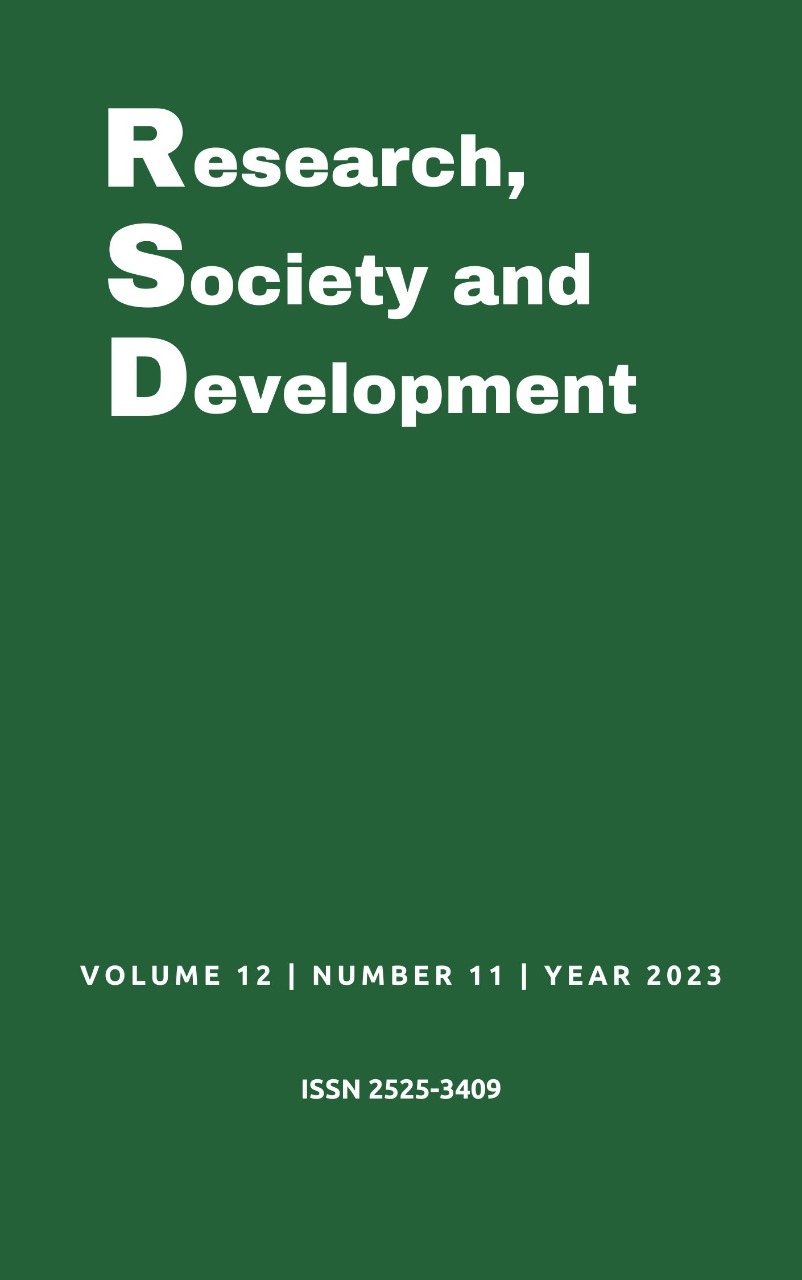As subnotificações dos casos de sífilis congênita e suas implicações na infecção: Uma revisão integrativa
DOI:
https://doi.org/10.33448/rsd-v12i11.43575Palavras-chave:
Sífilis, Sífilis congênita, Notificação, Notificação de doenças, Sistema de informação em saúde.Resumo
Objetivo: Analisar os aspectos envolvidos com as subnotificações dos casos de sífilis congênita (SC) e suas implicações para o manejo e/ou tratamento da infecção. Métodos: As buscas ocorreram entre fevereiro e maio de 2023 em cinco bases de dados, LILACS, Web of Science, Scopus, Medline e PubMed. Os critérios para seleção dos artigos foram, os disponíveis na íntegra, os respondessem à questão norteadora, e qualquer idioma. Resultados: A partir da pesquisa realizada, foram obtidos 81 resultados, porém apenas 6 artigos responderam aos critérios impostos. É possível citar que a subnotificação e/ou não tratamento, pode levar a desfechos negativos, tais como: aborto, óbito fetal e sequelas motoras, cognitivas, neurológicas, visuais e auditivas. O tratamento também pode ser prejudicado diante das subnotificações, pois isso pode desfavorecer o fornecimento das medicações e consequentemente a falha no tratamento. As dificuldades por parte dos profissionais quanto a notificação também é retratada nos estudos, o que compromete os dados dispostos no Sistema de Informação de Agravos de Notificação (SINAN), resultando em subnotificação de casos de SC, e dificultando que órgãos governamentais possam agir com ações de promoção, prevenção e tratamento adequado. Conclusões: É possível concluir que a subnotificação da SC possui múltiplas causas e que o não preenchimento da ficha de notificação implica diretamente na saúde materno-infantil de forma negativa.
Referências
Almeida, A. S. et al. (2021). Sífilis na gestação, fatores associados à sífilis congênita e condições do recém-nascido ao nascer. Texto e Contexto Enfermagem, 30(e20200423), 1-13.
Alves, P. I. C. et al. (2020). Evolução temporal e caracterização dos casos de sífilis congênita em Minas Gerais, Brasil, 2007-2015. Ciência e saúde coletiva, 25(8), 2949-2960.
Belo, M. M. A. et al. (2021). Estimativa da subnotificação dos óbitos por sífilis congênita no Recife, Pernambuco, 2010-2016: relacionamento entre os sistemas de informações sobre mortalidade e de agravos de notificação. Epidemiol. Serv. Saúde, 30(3), 1-9.
Benzaken, A. S. et al. (2020). Adequacy of prenatal care, diagnosis and treatment of syphilis in pregnancy: a study with open data from Brazilian state capitals. Cad Saúde Pública, 36(1), 1-13.
Brasil, Ministério da Saúde. (2022). Secretaria de Vigilância em Saúde. Departamento de Doenças de Condições Crônicas e Infecções Sexualmente Transmissíveis. Brasília. https://www.gov.br/saude/pt-br/centrais-de-conteudo/publicacoes/boletins/epidemiologicos/especiais/2022/boletim-epidemiologico-de-sifilis-numero-especial-out-2022/view.
Brasil, Ministério da Saúde. (2017). Secretaria de Vigilância em Saúde. Brasília. http://antigo.aids.gov.br/pt-br/pub/2017/boletim-epidemiologico-de-sifilis-2017.
Brito, C. V. B., Formigosa, C. A. C., & Neto, O. S. M. (2022). Impacto da COVID-19 em doenças de notificação compulsória no Norte do Brasil. Rev Bras Promoção Saúde, 35(12777), 1-11.
Canto, S. V. E. et al. (2019). Fetal and infant mortality of congenital syphilis reported to the Health Information System. Plos one, 14(1), 1-11.
Carvalho, M. C. J. et al. (2022). Mudanças de incidência e classificações clínicas da sífilis em gestantes pela pandemia do COVID - 19. Research Society and Development, 11(4), 1-11.
Domingues, C. S. V. et al. (2021). Protocolo Brasileiro para Infecções Sexualmente Transmissíveis 2020: vigilância epidemiológica. Epidemiol Serv Saúde, 30(1), 1-12.
Heath, K. et al. (2022). WHO method for estimating congenital syphilis to inform surveillance and service provision Paraguay. Bull World Health Organ, 100, 231-236.
Lucio, P. C. et al. (2023). Sífilis congênita e gestacional no Sudeste Brasileiro. Saúde Meio Ambient, 12, 107-122.
MacieL, D. P. A. et al. (2023). Mortalidade por sífilis congênita: Revisão sistemática. Rev Mult Saúde, 4(1), 106-116.
MOHER, D. et al. (2009). Preferred Reporting Items for Systematic Reviews and Meta-Analyses: The PRISMA Statement. Plos Medicine, 151(4), 1-6.
Oliveira, I. M., Oliveira, R. P. B., & Alves, R. R. F. (2020). Diagnóstico, tratamento e notificação da sífilis durante a gestação em Goiás de 2007 a 2017. Rev Saude Pública, 55(68), 1-9.
Santos, P. et al. (2023). Sífilis congênita no Paraná: uma análise de série histórica (2012-2021). Spac Saúde, 24(e931), 1-14.
Silva, A. A. O. et al. (2022). Spatiotemporal distribution analysis of syphilis in Brazil: Cases of congenital and syphilis in pregnant women from 2001–2017. Plos one, 17(10), 1-19.
Serruya, S. J. et al. (2015). Maternal and congenital syphilis in selected Latin America and Caribbean countries: a multi-country analysis using data from the Perinatal Information System. Sexual Health, 12(2), 164-169.
Soares, M. A. S., & Aquino, R. (2021). Completude e caracterização dos registros de sífilis gestacional e congênita na Bahia, 2007-2017. Epidemiol. Serv. Saúde, 30(4), 1-11.
Swayze, E. J. et al. (2021). Failure to recognize Low non treponemal titer syphilis infections in pregnancy May lead to widespread under-treatment. International Journal of Infectious Diseases, 104, 27-33.
Vescovi, J. S., & Trevisol, F. S. (2020). Aumento da incidência de sífilis congênita no estado de Santa Catarina no período de 2007 a 2017: análise da tendência temporal. Rev Paul Pediatr, 38(e2018390), 1-8.
Downloads
Publicado
Edição
Seção
Licença
Copyright (c) 2023 Thaís Latanzio Soares de Almeida; Ana Paula Pinho Carvalheira; Ivana Regina Gonçalves; Anelisa Soares de Almeida

Este trabalho está licenciado sob uma licença Creative Commons Attribution 4.0 International License.
Autores que publicam nesta revista concordam com os seguintes termos:
1) Autores mantém os direitos autorais e concedem à revista o direito de primeira publicação, com o trabalho simultaneamente licenciado sob a Licença Creative Commons Attribution que permite o compartilhamento do trabalho com reconhecimento da autoria e publicação inicial nesta revista.
2) Autores têm autorização para assumir contratos adicionais separadamente, para distribuição não-exclusiva da versão do trabalho publicada nesta revista (ex.: publicar em repositório institucional ou como capítulo de livro), com reconhecimento de autoria e publicação inicial nesta revista.
3) Autores têm permissão e são estimulados a publicar e distribuir seu trabalho online (ex.: em repositórios institucionais ou na sua página pessoal) a qualquer ponto antes ou durante o processo editorial, já que isso pode gerar alterações produtivas, bem como aumentar o impacto e a citação do trabalho publicado.


